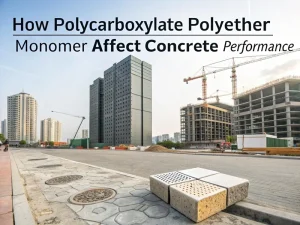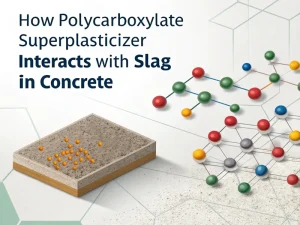Blog
In the fields of materials science and architecture, the terms “plasticizer” and “superplasticizer” often appear, but their differences may confuse many people. Despite having similar prefixes and both additives improving the workability of concrete, their purposes and chemical properties are different. This article aims to delve into the key differences between plasticizers and superplasticizers and elucidate their unique roles in various industries.
Any substance added to polymer materials that can increase the plasticity of the polymer is called a plasticizer. Plasticizers are usually low molecular weight organic compounds. They work by reducing intermolecular forces between polymer chains.
The use of plasticizers can improve the performance of polymer materials, reduce production costs, and increase production efficiency. They are an important type of chemical product additive commonly used as additives in materials such as plastic products, concrete, plaster, cement, gypsum, cosmetics, and cleaning agents.
Superplasticizer is a chemical additive mainly used in the construction industry, especially in concrete. Superplasticizers are typically high molecular weight polymers, typically based on polycarboxylate ethers (PCE) or naphthalene sulfonate formaldehyde (NSF).
Their complex molecular structure contains functional groups that can adsorb on the surface of cement particles. For example, PCE-based superplasticizers have a comb-like molecular structure, with long side chains extending into aqueous solutions, resulting in steric hindrance effects.
There are many types of plasticizers, including phthalates, aliphatic diesters, fatty acid esters, phenylpropanoids, polyol esters, epoxides, alkyl sulfates, etc.
Plasticizers usually have polarity or partial polarity in their structure. They are high boiling point, non-volatile liquids, or low melting point solids with good miscibility with polymers. Plasticizers are distributed between large molecular chains, which can reduce intermolecular forces, lower polymer viscosity, and enhance flexibility.
The definition of plasticizers is relatively broader, but the difference between plasticizers and superplasticizers is mainly compared in the field of concrete applications.
Plasticizers are used in the field of concrete, represented by lignosulfonates, with a water reduction rate of not less than 8%.
Common types of superplasticizers include polycarboxylate ethers (PCE) and sulfonated naphthaldehyde (SNF).
In concrete, their main function is to effectively disperse cement particles. When added to concrete mixtures, superplasticizers will adsorb onto the surface of cement particles, resulting in negative charges. Due to the mutual repulsion of charges of the same type, cement particles will be pushed away, damaging the flocs formed during the mixing process. This dispersing effect reduces the amount of water required to achieve concrete workability.
Compared with plasticizers, superplasticizers have a water reduction rate of not less than 14%.
Plasticizers are widely used in various industries, such as plastic products, rubber, plastic films, biodegradable plastics, polymer materials, chemical materials, automotive manufacturing, electronics and electronics, nanomaterials, aviation, aerospace, food hygiene, coatings and adhesives, textile printing and dyeing, papermaking, ink, cleaning agents, cosmetics, leather, and cleaning agents.
In this article, we discuss more about its application in the construction industry. Lignosulfonate superplasticizer is a common plasticizer belonging to anionic surfactants, which can be used directly or as one of the raw materials for composite additives. Due to its low price, it is still widely used. Used in mortar, it can improve workability and fluidity, increase strength, and reduce water content by 8% -10%.
The water reduction rate of superplasticizers can reach over 20%. Mainly naphthalene-based, melamine-based, and water-reducing agents compounded from them. The new generation of polycarboxylate superplasticizers has a water reduction rate of over 40%.
Superplasticizers are mainly used in the construction industry. They are crucial in the production of high-performance concrete, self-compacting concrete, and precast concrete components. Tall buildings, bridges, and large infrastructure projects often rely on superplasticizers to ensure that concrete can be efficiently poured into complex templates, reach difficult locations, and achieve high strength and durability.
For example, in the construction of large-span bridges, self-compacting concrete containing superplasticizers can be poured without vibration, thereby reducing the risk of honeycombing and improving the overall quality of the structure.
Understanding the difference between plasticizers and superplasticizers is crucial for construction professionals. Although both additives can improve the workability of concrete, their modes of action are different and suitable for different applications. By selecting appropriate additives, engineers and contractors can improve the performance of concrete and ensure a more robust and durable structure.

How Polycarboxylate Polyether Monomer Affect Concrete Performance
Blog How Polycarboxylate

How Polycarboxylate Superplasticizer Interacts With Slag In Concrete
Blog How Polycarboxylate